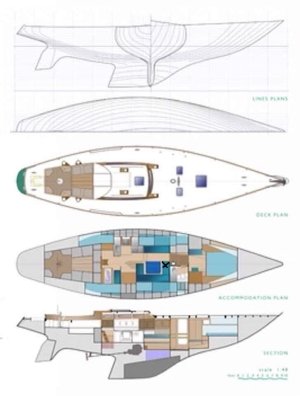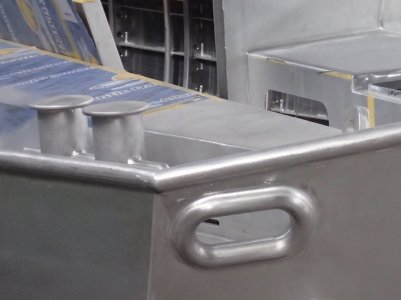dgadee
Well-Known Member
Are there ever side loads on a drogue? That might rip the toerail off bolt by bolt.They sometimes are. I have s/s sandwich plates to bolt to my toerail. 150 M8 bolts each side should be enough
Are there ever side loads on a drogue? That might rip the toerail off bolt by bolt.They sometimes are. I have s/s sandwich plates to bolt to my toerail. 150 M8 bolts each side should be enough
I have never used it anger but I had the same thought.Are there ever side loads on a drogue? That might rip the toerail off bolt by bolt.
I think it depends on the engineering of the toerail. Mine is an integral part of the hull/deck join, and I can't imagine any chain plate type structure being stronger. But a toerail that is bolted on and not part of the structure might not be so strong. That said, mine is probably too high to be a good attachment point for a drogue - freeboard at the stern is well over a metre, maybe 1.5m, and I suspect there would be too great a downward force. Just visualising it, I guess you want the pull of the drogue to be level with the centre of buoyancy?They sometimes are. I have s/s sandwich plates to bolt to my toerail. 150 M8 bolts each side should be enough
... What am I overlooking?
You've still just eyeballed it, to call it engineering would require some adding up.If it was me, I would add side plates to the quarter, just below the gunwale. Inside I would build up the GRP to make a much thicker area with the GRP shaped to distribute the loading as evenly as possible i.e. tear drop shaped, tapered layers of cloth.
* You've still just eyeballed it, to call it engineering would require some adding up.
** Cleats might well be designed to take the weight of the boat for all I know.
*** It's perhaps also worth considering the breaking strength of the rope that's transmitting the load it can't be more than that can it?
**** Could you put enough stretch in with octoplait nylon to significantly reduce snatch loads?
***** Can you say that with a bridle on two cleats that the load is halved or could it still load up entirely on one side if the boat sheared?
I think that's what I was saying to the other guy. To do it right requires an engineer to design it for the specific boat.Er....
* That's been done for me by pros in composites structural engineering, found via Sailing Anarchy. Checked valid by another pro in the UK.
Under normal operation the load on the bridles would be around 250 Kg. It is only for an exceptional wave strike that Jordan's design had the higher figures, so with everything secured well as you propose, it will be good.


I think we need a clear idea of what we're trying to achieve with a Jordan Series Drogue, before we get too far into the minutiae of how we do it.
'A breaking sea >60% of a boat's length will ALWAYS roll a boat which is beam on....'
Those sea conditions happen quite frequently for a <30' boat ( e.g. Jesters ) in 'home waters'. They happen often for up to 50' boats on a Biscay passage....
What would the force be of that when taken on the stern?I came across this short video-clip, which should remind us of what the problem looks like...
That was the punitive breaker wave as he had stolen the boatI came across this short video-clip, which should remind us of what the problem looks like...
He didn't sell them. He gave away the design so others could build their own or have them made. Most European sailors don't need one if you are coastal cruising.Did the designer/seller of these Drogues go bust? If everyone who attempted to buy one was advised to uprate/rebuild their boats to the standards that some people are suggesting, I doubt he sold very many. Certainly none to the major European boat makers I would think.
A drogue is a specialised piece of equipment that is likely to be carried only by some long distance cruising boats, so the market is quite small. A suitable attachment point can be fabricated for most production yachts. Yachts contemplating carrying a JSD will typically have already been modified with additions such as solar panels, extra shade, davits, larger battery bank, more significant ground tackle etc. Installing attachment points for a JSD is just one additional modification.Did the designer/seller of these Drogues go bust? If everyone who attempted to buy one was advised to uprate/rebuild their boats to the standards that some people are suggesting, I doubt he sold very many. Certainly none to the major European boat makers I would think.